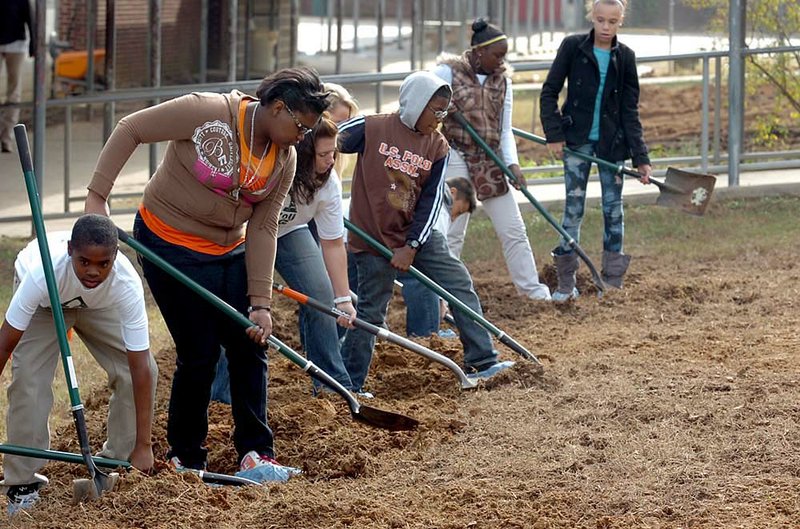LITTLE ROCK — A group of 11-year-old children gathered around the end of a shovel, staring at a tiny grub writhing among the clods of black soil resting in its metal scoop.
The students wore paper booties to protect their shoes as they wielded garden tools, turning the ground outside of Mabelvale Middle School in southwest Little Rock to expand a garden planted in its lawn.
“I’ve never picked up a worm before,” sixth-grader Dara Custis said as she tossed the creature into a cardboard box containing food for chickens in a nearby cage.
Researchers with the Delta Garden Study worked last week to guide the garden expansion, which will allow the students to continue to cultivate their own vegetables and flowers into the spring months.
The project is a cooperative venture between Arkansas Children’s Hospital Research Institute and the U.S. Department of Agriculture Research Services Delta Obesity Prevention Research Unit.
A third of an acre, used to launch the project, was already planted and growing when classes started at the beginning of the school year.
“The school bonding part of the project really requires them to build the rest of the garden themselves,” said Judith L. Weber, associate professor of pediatrics at the University of Arkansas for Medical Sciences. “They need to learn from the ground up.”
She gestured to the students behind her, who were learning about chickens as they stared at the grub, exercising their muscles as they shoveled the soil and developing relationships as they worked side by side.
The Delta Garden Study, funded by a $2 million grant from the USDA, seeks to gauge the effects cultivating a garden has on students’ academic achievement, behavior and attitudes about school.
As Mabelvale students expanded the pilot garden in their schoolyard, organizers prepared to create similar plots in nine more schools.
Each of the schools will start their own gardens next fall. Researchers will evaluate participating students’ standardized test scores, body-mass indexes, disciplinary records and responses to a survey about high-risk behaviors, such as drug use.
They will document the progress of at least 200 students at each school, comparing their results with control groups at demographically similar schools that don’t have gardens, Weber said.
“We’re gratified by the fact that students have enjoyed this as much as we thought they would,” she said.
As they worked, adults stopped to trade stories with the children. The children talked of many experiences they’d had for the first time in the garden, from Custis’ grub find to 12-year-old Victoria Thrower’s discovery that she might like braised greens in addition to her favorite food, yellow cake.
“My mama said I need to get some vegetables in my system,” she said.
As the children worked, volunteers from the University of Arkansas Clinton School of Public Service prepared dishes from the vegetables grown in the garden, each developed by Terese Post, the chef at the Winthrop Rockefeller Institute, using a small number of simple ingredients.
“I’m gonna tell my mama to try these recipes,” Victoria said.
Gardening has spread quickly through many public schools over the past decade.
First lady Michelle Obama focused attention on the idea when she invited public school students to help her plant a garden in the White House lawn.
Also, many city governments are starting to support community gardens, as residents push for more amenities.
In Siloam Springs, master gardeners maintain a plot outside of a homeless shelter, providing fresh vegetables for low-income families accustomed to canned and preserved food-pantry fare.
In Little Rock, pupils at Dunbar Magnet Middle and Gibbs Elementary schools work in a garden situated between the two buildings.
The Delta Garden Project’s success may result in more funding of these projects, Weber said. The project includes lesson plans aligned with the state’s curriculum frameworks.
A federal grant pays for supplies to build raised beds, rainwater-collection barrels and to rehabilitate greenhouses on the campuses. It also pays the salaries of fulltime garden managers for one year.
After that year, students in “garden clubs” can sell the produce to help pay a $4,000 stipend for an AmeriCorps volunteer to maintain the gardens, Weber said.
Project Manager Emily English said she’s eager to document the public health benefits of introducing children to new vegetables.
The gardens include common vegetables, like tomatoes and corn, planted alongside less familiar items, like mustard greens and Swiss chard.
“We plant things they’re probably familiar with and things they probably haven’t tried before,” she said.
Students pushing bites of sweet potato rosemary soup and salad dressed in balsamic vinaigrette on disposable plates had mixed reactions about the food, but they seemed eager to pick up a shovel when it was their turn to dig.
“What’s a grub?” one shouted, as Custis dropped another find into the cardboard box.
Arkansas, Pages 13 on 11/26/2010
